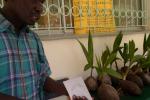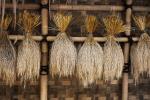News and blogs
A new 15 minute film documents a gathering of indigenous farmers from mountain communities around the world to exchange knowledge and ideas about protecting biodiversity and culture as the basis for adapting to climate change.
There is a growing recognition that living well must go beyond economic and material plenty to encompass social and spiritual well-being. But what do we understand by these wider aspects of well-being?
Governments in industrial countries regularly put pressure on developing countries to introduce stringent plant variety protection (PVP) regimes and to adhere to the 1991 Act of the UPOV Convention, without duly considering its consequences on the enjoyment of human rights of vulnerable groups such as small-scale farmers and in particular women.
These photos document a gathering of indigenous groups from China, Bhutan, and Peru. They met in the spring to discuss climate change and plan a crop exchange program.
First published on August 18, by Adam Kerby in YES! Magazine.
Indigenous people have the solutions to climate change. They should be allowed to speak out at the UN climate talks.
First published on 29 July, by Alejandro Argumedo in Responding to Climate Change (RTCC).
Modern breeding techniques, GM crop imports and commercial seeds mean that many of China’s local varieties are under threat
Article in Langscape Magazine explores these concepts in the context of the SIFOR project.
A side event hosted by the Quaker United Nations Office (QUNO) this week called on negotiators at the World Intellectual Property Organization to include innovation by small-scale farmers and asked for complementarity of several international instruments dealing with this issue.

Local newspaper reports on the innovations identified by SIFOR project communities in Kilifi and Kwale counties.
The meeting of the Working Group on Article 8(j) in Montreal (7-11 October), reaffirmed the need to recognize and integrate traditional knowledge systems of indigenous and local communities into the work of the Convention on Biological Diversity.
Peruvian indigenous farmers have been angered by a government research agency that has claimed it owns intellectual property (IP) rights over more than fifty traditional varieties of potatoes bred in the Peruvian Andes.

This week, from 24 to 28 September, witnesses the opening in Oman of the Fifth Session of the Governing Body of the International Treaty on Plant Genetic Resources for Food and Agriculture, also known as the seed treaty.
On 24th July 2013, the first SIFOR stakeholder workshop in the Central Himalayas brought together over 100 participants - leading scientists, local farmers, state governments and NGOs.